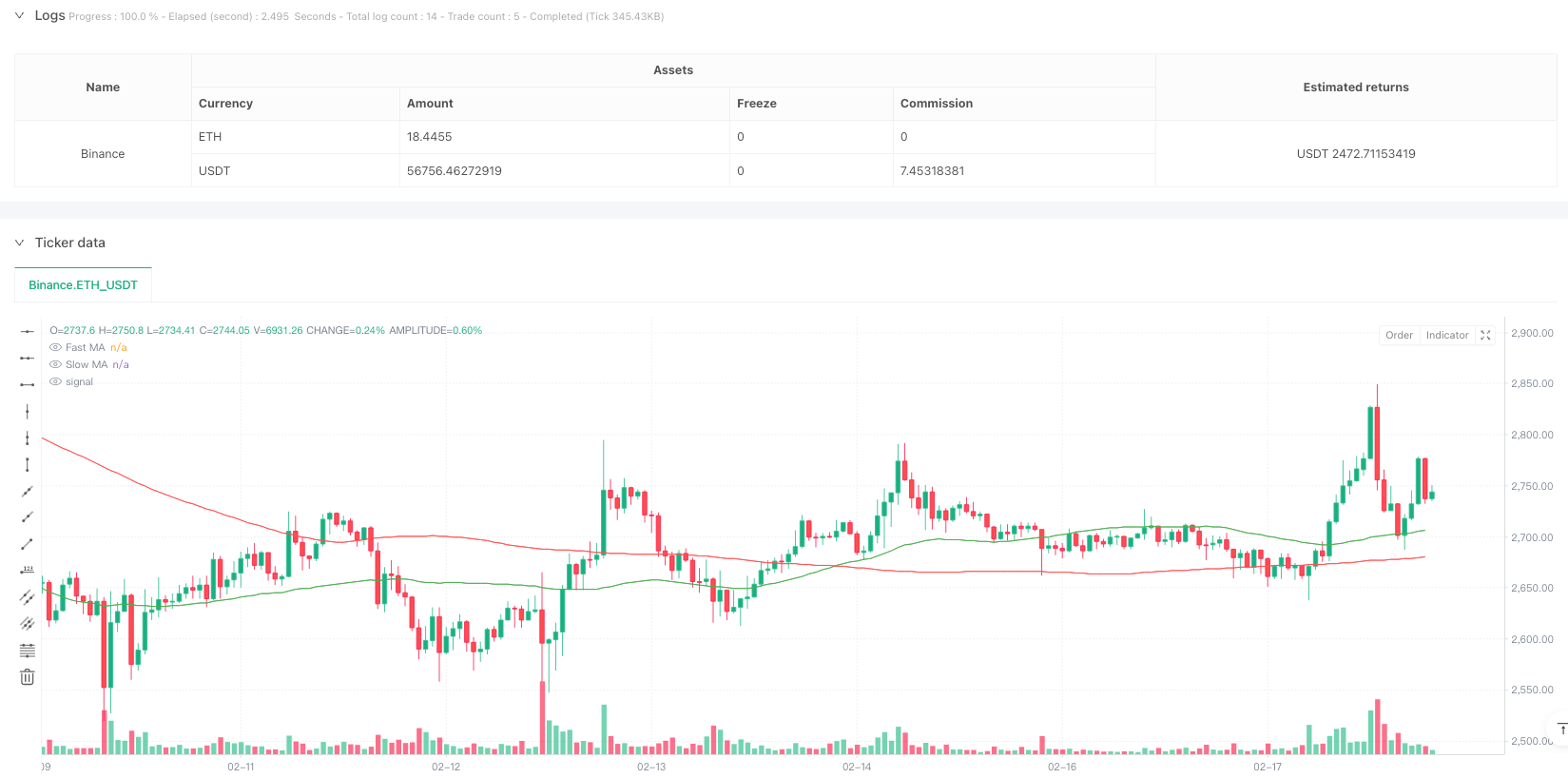

概述
该策略是一个结合了多重技术指标的量化交易系统,通过移动平均线(MA)、相对强弱指标(RSI)和移动平均线趋同散度(MACD)三个经典技术指标的协同配合,构建了一个完整的交易信号系统。策略采用趋势跟踪与动量识别相结合的方式,在保证交易方向正确的同时,也注重入场时机的把握。同时集成了止损、止盈和追踪止损等风险控制机制,形成了一个系统化的交易策略。
策略原理
策略主要基于以下三个层面构建交易信号: 1. 趋势判断:使用50日与200日双均线系统,通过金叉死叉判断大趋势方向 2. 动量确认:结合RSI超买超卖水平(70⁄30)与MACD金叉死叉,验证价格动量 3. 风险控制:设置2%止损、4%止盈以及1%追踪止损,构建完整的风险管理体系
具体来说,当快速均线(50日)上穿慢速均线(200日)形成金叉,同时RSI未达到超买水平且MACD形成金叉时,系统产生做多信号。反之,当出现死叉且RSI未达到超卖水平、MACD形成死叉时,系统产生做空信号。
策略优势
- 信号可靠性高:通过多重指标交叉验证,能有效过滤虚假信号
- 趋势把握准确:采用经典的双均线系统,能较好地捕捉主要趋势
- 风险控制完善:综合运用多种止损方式,有效控制下行风险
- 适应性强:策略参数可调整性强,能适应不同市场环境
- 执行明确:信号生成条件清晰,避免主观判断带来的干扰
策略风险
- 滞后性风险:移动平均线本身具有滞后性,可能错过最佳入场时机
- 震荡市场风险:在横盘震荡市场中,可能频繁产生假突破信号
- 参数优化风险:过度优化参数可能导致过拟合,影响策略的稳定性
- 成本控制风险:频繁交易可能带来较高的交易成本
- 市场环境依赖:策略在趋势明显的市场中表现更好,但在其他市场环境下效果可能不佳
策略优化方向
- 引入成交量指标:在现有信号系统中增加成交量确认,提高信号可靠性
- 优化参数自适应:开发参数动态调整机制,提高策略对市场的适应性
- 增加市场情绪指标:引入VIX等情绪指标,优化入场时机
- 完善止损机制:开发更灵活的止损方案,如基于ATR的动态止损
- 加入波动率过滤:在高波动率环境下调整仓位,优化风险收益比
总结
该策略通过多重技术指标的协同配合,构建了一个相对完整的交易系统。策略在趋势明显的市场中表现较好,但仍需要根据实际市场情况进行优化调整。建议交易者在实盘使用时,先进行充分的回测验证,并根据自身风险承受能力调整参数设置。策略的核心优势在于系统化的信号生成机制和完善的风险控制体系,这使其具有较好的实战应用价值。
策略源码
/*backtest
start: 2024-06-01 00:00:00
end: 2025-02-18 08:00:00
period: 1h
basePeriod: 1h
exchanges: [{"eid":"Binance","currency":"ETH_USDT"}]
*/
// This Pine Script™ code is subject to the terms of the Mozilla Public License 2.0 at https://mozilla.org/MPL/2.0/
// © EthioTrader
//@version=5
strategy("Optimal Multi-Indicator Strategy", overlay=true, initial_capital=10000, default_qty_type=strategy.percent_of_equity, default_qty_value=10, commission_type=strategy.commission.percent, commission_value=0.1)
// ===== Input Parameters =====
// Moving Averages
fastMA = ta.sma(close, 50)
slowMA = ta.sma(close, 200)
plot(fastMA, "Fast MA", color=color.green)
plot(slowMA, "Slow MA", color=color.red)
// RSI
rsiLength = input(14, "RSI Length")
rsiOverbought = input(70, "RSI Overbought")
rsiOversold = input(30, "RSI Oversold")
rsi = ta.rsi(close, rsiLength)
// MACD
[macdLine, signalLine, _] = ta.macd(close, 12, 26, 9)
// Risk Management
stopLossPerc = input(2.0, "Stop Loss (%)") / 100
takeProfitPerc = input(4.0, "Take Profit (%)") / 100
trailingStopPerc = input(1.0, "Trailing Stop (%)") / 100
// ===== Strategy Logic =====
// Trend Condition: Golden Cross (Fast MA > Slow MA)
bullishTrend = ta.crossover(fastMA, slowMA)
bearishTrend = ta.crossunder(fastMA, slowMA)
// Momentum Condition: RSI and MACD
bullishMomentum = rsi < rsiOverbought and ta.crossover(macdLine, signalLine)
bearishMomentum = rsi > rsiOversold and ta.crossunder(macdLine, signalLine)
// Entry Signals
longCondition = bullishTrend and bullishMomentum
shortCondition = bearishTrend and bearishMomentum
// Exit Signals
trailingStop = strategy.position_avg_price * (1 - trailingStopPerc)
exitLong = ta.crossunder(close, trailingStop) or (close >= strategy.position_avg_price * (1 + takeProfitPerc))
exitShort = ta.crossover(close, trailingStop) or (close <= strategy.position_avg_price * (1 - takeProfitPerc))
// ===== Execute Orders =====
if (longCondition)
strategy.entry("Long", strategy.long)
strategy.exit("Exit Long", "Long", stop=strategy.position_avg_price * (1 - stopLossPerc), limit=strategy.position_avg_price * (1 + takeProfitPerc), trail_price=trailingStop, trail_offset=trailingStopPerc * close)
if (shortCondition)
strategy.entry("Short", strategy.short)
strategy.exit("Exit Short", "Short", stop=strategy.position_avg_price * (1 + stopLossPerc), limit=strategy.position_avg_price * (1 - takeProfitPerc), trail_price=trailingStop, trail_offset=trailingStopPerc * close)
// ===== Plotting =====
plotshape(series=longCondition, title="Buy Signal", location=location.belowbar, color=color.green, style=shape.labelup, text="BUY")
plotshape(series=shortCondition, title="Sell Signal", location=location.abovebar, color=color.red, style=shape.labeldown, text="SELL")
相关推荐